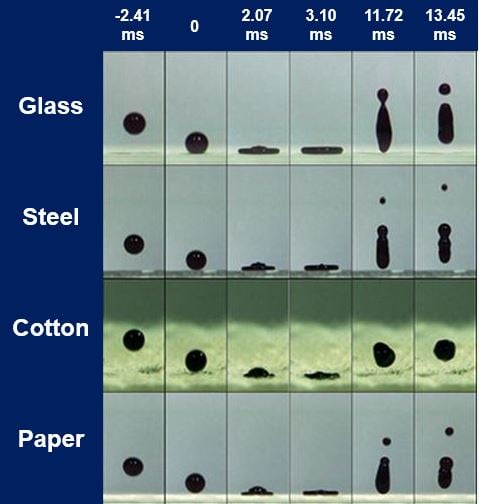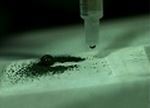The dream of never having to clean your car, windows or clothes may soon become a reality, say scientists from University College London, Imperial College London, and Dalian University of Technology in China, who developed a new self-cleaning paint.
When the paint is applied to glass, paper, clothes and steel, and combined with adhesives, it maintains its self-cleaning properties even after being scratched with a knife, scuffed with sandpaper or wiped with a cloth.
Self-cleaning surfaces work by being extremely water-repellent, however, they typically stop working when they are exposed to oil or damaged.

Time-lapsed photos of water droplets bouncing of glass, steel, cotton wool and filter paper surfaces treated with the special paint. (Image Credit: Lu Yao, UCL)
This new paint creates a much more resilient surface that is resistant to everyday ** wear and tear. The research team says it could be used for a wide range of real-world applications from cars to clothing.
** Wear and tear refers to the gradual decline in the quality of something after regular usage.
First author Yao Lu said:
“Being waterproof allows materials to self-clean as water forms marble-shaped droplets that roll over the surface, acting like miniature vacuum cleaners picking up dirt, viruses and bacteria along the way.”
“For this to happen, the surface must be rough and waxy, so we set out to create these conditions on hard and soft surfaces by designing our own paint and combining it with different adhesives to help the surfaces withstand damage.”
The study, which has been published in the academic journal Science (citation below), shows how this new paint made from coated titanium dioxide nanoparticles can keep a wide-range of materials clean, even if they are immersed in oil or if their surfaces are damaged.
The researchers used a variety of methods to create the water-repellent surfaces, depending on the type of material. They used an artist’s spray-gun to coat steel and glass, a syringe to apply paint onto paper, and dip-coating for cotton wool.
Materials became self-cleaning and waterproof
After the paint was applied, all the materials became both self-cleaning and waterproof as water droplets of various sizes were seen bouncing off rather than wetting the surface, removing the dirt the researchers had applied.
The materials’ waterproof and self-cleaning properties were maintained even after damage was inflicted on the surfaces.
Mr. Lu explained:
“Our paint worked extremely well for a variety of surfaces in tough conditions which were designed to simulate the wear and tear of materials in the real-world. For example, car paint frequently gets scuffed and scratched and we wanted to make sure our paint would survive that.”
“As well as practical uses, the paint could also be used creatively to make art with water which is something I have been exploring in my own time.”
In their experiments, they filmed materials with the special paint applied as well as controls (materials without the paint). For example, they filmed cotton-wool being dipped into blue-coloured water, and emerging super-clean white with no trace of blue at all. They also showed how treated paper remained dry after being exposed to water and dirt.
Co-author, Prof. Claire Carmalt, who works at UCL Chemistry, said:
“The biggest challenge for the widespread application of self-cleaning surfaces is finding a way to make them tough enough to withstand everyday damage.”
“The surfaces tend to be mechanically weak and so rub off easily, but by pairing our paint with different adhesives, we’ve shown it is possible to make a robust self-cleaning surface. We used materials that are readily available so our methods can be scaled-up for industrial applications.”
Corresponding author, Prof. Ivan Parking, Head of UCL Chemistry, said:
“Our work aims to characterise new materials at a very small scale so we can see how best to use them to improve our daily lives. The new paint fits into a broader portfolio of surfaces we are developing for different purposes, including antimicrobial coatings to combat hospital acquired infections, and we hope its discovery advances the widespread adoption of self-cleaning surfaces.”
Citation: “Robust self-cleaning surfaces that function when exposed to either air or oil,” Yao Lu, Sanjayan Sathasivam, Jinlong Song, Colin R. Crick, Claire J. Carmalt, and Ivan P. Parkin. Science 6 March 2015: 347 (6226), 1132-1135. [DOI:10.1126/science.aaa0946]
Video – Self-cleaning coating
UCL scientists discuss the treatment they have developed, which can turn many materials including metal, glass and fabric into highly water repellent and self-cleaning surfaces.

